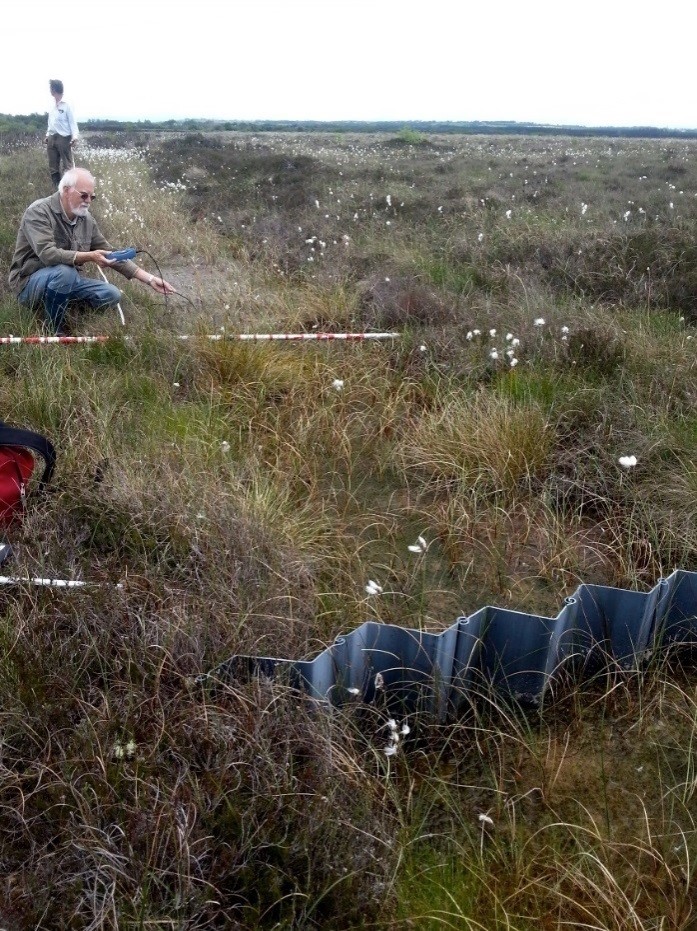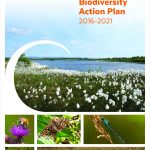If you travel through the Irish midlands, you will eventually…
Volunteer-led peatland restoration battles climate change and enhances these unique habitats for native wildlife
Catherine O’Connell tells us how volunteers are helping the Irish Peatland Conservation Council restore bogs in Ireland by blocking drains and rewetting these unique habitats– and how these efforts can take decades to see results.
In the lifetime of a peatland, which can exceed 10,000 years, the peatland stores soil carbon in the form of partially decomposed plant remains or peat. High water table levels prevent aerobic decomposition and allow for the accumulation of peat. In terms of greenhouse gas management, the maintenance of large stores of carbon in undisturbed peatlands is a priority. Drainage of peatlands directly contributes to the release of stored carbon from a peatland through the process of decomposition.
Every peatland habitat in Ireland has been affected by drainage for turf cutting, peat harvesting, forestry and reclamation. These man-made impacts have led to the loss of 80% of the habitat and have been responsible for releasing millions of tonnes of greenhouse gases into the atmosphere to fuel global warming. Active management is urgently needed to restore the hydrology and the carbon storage functions of peatlands.
Site restoration is a costly and time-consuming business. It takes decades to reverse the effects of drainage on bog hydrology. Drains inserted in peatlands mostly for peat extraction lower the water table and dry out the surface peat layer (which is 98% water) sufficiently to allow machinery access to extract turf. Once the bog begins to dry, the peat layer oxidises and shrinks creating a slope. Rainfall landing on the bog surface no longer percolates slowly across the site but discharges quickly from the bog. Changes also occur in vegetation composition. The peat forming Sphagnum mosses die back and are replaced by the non-peat forming mosses which can tolerate the shade cast by the luxurious growth of Ling Heather in the drier conditions. Essentially the peat forming function of the peatland is halted. The challenge for peatland managers is to restore this function. Peat formation requires a shallow slope (usually 0.3%), a supply of rainwater and the presence of Sphagnum mosses. The Irish Peatland Conservation Council (IPCC) own and manage a network of five peatlands throughout the country. These include examples of the three main peatland types occurring in Ireland.
Over the years in the role of land managers IPCC have developed skills in drain blocking and habitat restoration. For example, on Lodge Bog in Co. Kildare we have blocked 4km of drains, using Geoflex drain piling made from recycled plastic. The lumbar is purchased in 3m lengths which are driven into bog drains using a mallet. It usually takes 4-6 lengths to block a drain – the sheets interlock with one another in a tongue and groove system. The positioning of drain blocks is determined by analysing the slope of the drain in a process called levelling. Regarding dam frequency, the rule of thumb is to insert a dam for every 10cm drop in the level of the drain with a minimum of three and maximum of ten dams per 100m length of drain. The objective of damming the drains is to bring the water table on the bog up so that it is within 10cm of the bog surface. Such a height is necessary to allow for subsequent growth of peat forming plants.
Volunteers are essential to this work as IPCC operate on vegetated sites that cannot accommodate drain blocking machinery. Where a particularly large main drain occurs on the bog it is blocked with a composite dam. This is constructed from two layers of drain piling with a layer of peat infilled between them.
Drain blocking really works well, and volunteers marvel at how rapidly the water backs up against a newly constructed dam. Rewetting the peat stops the process of decomposition and the release of carbon dioxide. IPCC have found on Lodge Bog that the refilled drains colonise with aquatic Sphagnum mosses within five years – the first positive change in the vegetation and the beginning of restoration to peat forming habitat (see Figures 1 and 2).

However not all Sphagnum species produce peat to the same extent. Bog pool species typically the first to colonise blocked drains have a relatively poor peat-forming capacity.
The hard-oxidised peat of the bog affected years of drainage can be resilient to rewetting and hostile to natural colonisation with Sphagnum mosses. IPCC use another technique to speed up the process of restoration.

On areas where the water table is consistently recorded within 10cm of the peat surface, Sphagnum transfer can be undertaken. This restoration technique was developed by Canadian peatland managers and involves collecting Sphagnum moss fragments and inoculating them onto fresh, bare, moist peat. IPCC carried out trials of this method on Lodge Bog between 2009 and 2013 and met with success. Since then we have used the technique on suitable sites in Girley Bog in Co. Meath.

Again, volunteers are essential as the Sphagnum transfer method is completed by hand. First drains are blocked to raise the water table to within 10cm of the bog surface. The dry oxidised peat is removed. Fragments of Sphagnum capillifolium are collected from a donor site and spread over the bare peat in a ratio of 1:10. The moss fragments must be covered with straw to help retain moisture on the bare peat surface until they begin to grow. Very positive results are seen on bogs using this method after three years (see Figure 3). Sphagnum capillifolium is a moderately peat-forming moss that can withstand alternating wet and dry conditions which makes it ideal for inoculation.
Table 1: Restoration Timeline for Irish Bogs
| Days/Weeks | Improvement of physical conditions |
| Weeks/Months | Improvement of chemical conditions |
| Months/Years | Improvement of biological conditions |
| Years/Decades | Topographical changes |
With the increased awareness of climate change, bog restoration is a sensible way to help maintain the carbon store that has been locked in the peat for up to 10,000 years, preventing this from leaking into the atmosphere. While the results of drain blocking may be seen within a matter of days, the restoration of peat formation involving recolonisation with Sphagnum mosses will take decades (see Table 1 above).
Catherine O’Connell, Irish Peatland Conservation Council
Learn more:
The IPCC on line Peatland Management Tool Kit provides
information on management skills and techniques currently in use
in Ireland in the restoration of peatlands – www.ipcc.ie/advice/
peatland-management-diy-tool-kit







